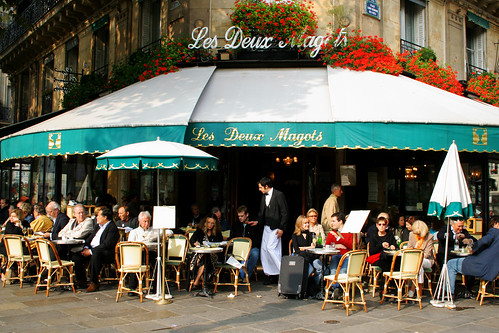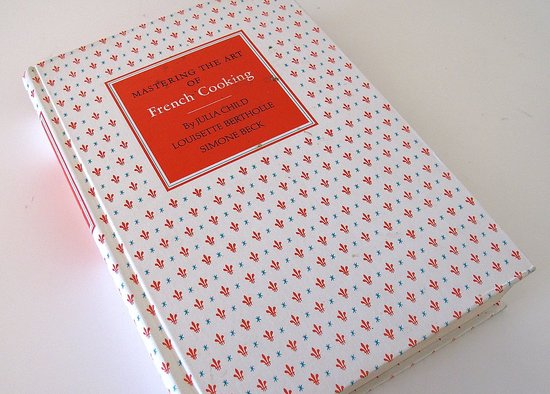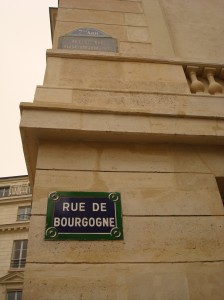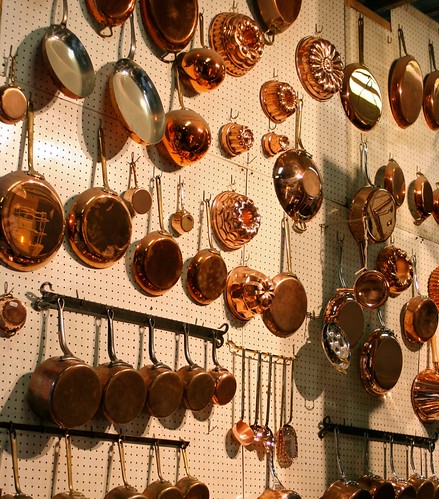The most influential woman in my life is undoubtedly my mother. From the very first day, she has been the most wonderful mother I could have asked for. She has served as a role model in every way imaginable and has taught me how to be a passionate, kind individual, how to apply myself wholeheartedly to everything I do, how to craft and sew, and how to cook.
Ever since I can remember, she had me in the kitchen learning, at first, to bake cookies, then, gradually, my Grandma’s pear cobbler and eventually dishes like my favorite ranch chicken and noodles. Even if there was, much to my Dad’s dismay, a flower dusting on the floor, cooking was and still is important to her, and she wanted to pass along that passion to me.
 |
| My Mom's Birthday Blueberry Poud Cake |
Now, as I am beginning to establish my own independence, my mom continues to remain an essential part of my life. I am currently studying abroad in Paris, one of the major fashion and cuisine capitals of the world. As such, I wanted to trace the steps of one of my mom’s culinary heroines, Julia Child, throughout her Paris days.
Julia Child first arrived in Paris in 1949 after her husband Paul, who worked with the Office of Strategic Serives, was transferred to the American Embassy in Paris. The French cuisine to which Julia was exposed inspired her to learn how to cook. She was one of the first women to graduate from Le Cordon Bleu, only to begin her own cooking school, L’Ecole des Trois Gourmandes, with the help of Simone Beck and Louisette Bertholle. They later published Mastering the Art of French Cooking, which became the first French cookbook written in English. This was revolutionary, as it suddenly gave American women, like my mom, access to French cuisine. As PBS’s Lessons with Master Chefs: Julia Child states, she “encouraged ‘home chefs’ to practice cooking as an art, not dread it as a chore.” Julia Child further revolutionized the way American women cooked through her multiple television shows and cookbooks.
For a tour of Julia Child’s Paris, begin your journey at Place de l’Ecole Militare in the 7th Arrondissement, or section of Paris. The best way to get is here by taking Line 8 on the Métro to Ecole Militaire. Then, take a right onto Avenue Bosquet and look for Rue de Champs de Mars, the first street on your left. Take a left here and continue to 24 Rue de Champs de Mars on your right.
This is the original location of Le Cordon Bleu, and is where Julia Child would have come to take her cooking courses. Even though Le Cordon Bleu is currently located at 8 Rue Léon Delhomene in the 15th Arrondissement, it remains one of the premier French cooking schools in the world. The culinary school was founded in 1895, following the success of the magazine La Cuisinière Cordon Bleu. Today, there are thirty-five Le Cordon Bleu schools in fifteen different countries, training over twenty thousand students each year. For those of you who are also black and white movie fans, Audrey Hepburn filmed on location at Le Cordon Bleu for the 1954 film Sabrina.
| 24 Rue de Champs de Mars |
This is the original location of Le Cordon Bleu, and is where Julia Child would have come to take her cooking courses. Even though Le Cordon Bleu is currently located at 8 Rue Léon Delhomene in the 15th Arrondissement, it remains one of the premier French cooking schools in the world. The culinary school was founded in 1895, following the success of the magazine La Cuisinière Cordon Bleu. Today, there are thirty-five Le Cordon Bleu schools in fifteen different countries, training over twenty thousand students each year. For those of you who are also black and white movie fans, Audrey Hepburn filmed on location at Le Cordon Bleu for the 1954 film Sabrina.
 |
| Julia Child Boning a Duck |
Retrace your steps back to Place de l’Ecole Militaire. Walk in a clock-wise direction around the traffic circle across Avenue Bosquet and Avenue de la Motte Picquet. Take a left on the next street, Avenue de Tourville, and continue until it intersects Boulevard des Invalides. Be sure to enjoy the Jardin de l'Intendant on your left as you walk.
Take a left on Boulevard des Invalides, and then a right at the first street on your right, Rue de Varenne. Fron there, take a left onto Rue de Bourgogne, the first street on your left. Continue on Rue de Bougogne until you reach Place du Bourbon. In the 1950’s, Rue de Bourgogne housed an open-air market which Julia preferred to another, larger market at Les Halles. Although it is common in the United States to buy all of your produce, meat, and dairy at one store, it was, and still is, common for Europeans to buy these different items at either separate stores or at market vendors. The food sold at markets is often more fresh, more natural, and more flavorful than its superstore counterpart. The market also served as a cultural and social hub for Paris, adding to its already delicious appeal.
 |
| Markets are a great way to experience a city's culture! |
From Place du Bourbon, take a right onto Rue de l’University, which Julia affectionately called ‘Rue de Loo.’ Continue across Boulevard Saint Germain, Rue de Solferino, and Rue de Bellechasse. Once you cross Rue de Bellechasse, look for 81 Rue de l’Université. Although there is no plaque to commemorate the building, Julia and Paul child used to live in the top two floors of the apartment during their stay in Paris. In fact, Julia loved Paris so much that she considered it her home. L’Ecole des Trois Gourmandes also met here, as it is where Julia first began experimenting with and teaching the art of cooking.
 |
| Julia's Old Haunt |
Continue on 'Rue de Loo' across Rue de Beaune and turn right on Rue des Saints Peres. Next, turn left on Boulevard Saint Germain and continue to Place Saint Germain de Près. At 6, Place Saint Germain de Près is Le Deux Magots, the restaurant where Paul and Julia ate at their first night in Paris. They ordered café complet. It is also where Ernest Hemingway, Jean-Paul Sartre, and other intellectuals used to meet to discuss their work. Pable Picasso also used to dine here. In keeping with its literary reputation, each year since 1933, a French novel is given the Deux Magots literary award.
 |
| Les Deux Magots |
From Les Deux Magots, turn onto Rue Bonaparte and continue to Qual Malaquais., which turns into Qual Voltaire. Continue on Qual Voltaire until you reach Pont du Carrousel on your right. Take a right onto the bridge, cross the bridge, and cross over Quai Francois to the Louvre. Enter the Jardin du Carrousel and continue around Place du Carrousel and exit on Rue de Rivoli. Cross Rue de Rivoli to Rue de Rohan, take a slight left, and continue onto Rue de Montpensier. Continue strait on this road until you reach Rue de Beaujoulas. At 17 Rue de Beaujolas is Le Grand Véfour, one of the most beautiful and most exclusive restaurants in Paris. The restaurant, which was opened in 1724, remains as it was when Julia visited there once a month with her husband. In addition to the Childs, it was also visited by Victor Hugo, Napoléon, and Jean Cocteau Colete.
 |
| The restaurant has not changed much since the 1950's. |
From Rue de Beaujolais, take a left onto Rue de Deux Pavillons to Rue Feuillade. Continue to Place des Victoires and turn right onto Rue Croix des Petits Champs. Turn left onto Rue Coquillière. The last stop on the tour, E. Dehillerin is located at 18-20 Rue Coquillère, and it is where Julia Child purchased her cookware. The best chef must have the best cooking utensils, and even though the store was established in 1820, it remains one of the most popular cookware stores in Paris. Be sure to explore the dazzling rows of copper pans and unique cooking gadgets that are sure to thrill even the most loyal Pampered Chef enthusiast.
I hope you have enjoyed wandering the streets of Paris, as Julia Child would have done in the early 1950’s. She truly is one of the most influential women in the world of cooking. Her death in 2004 was, indeed, a mournful day for the culinary world, but Julia can rest in peace knowing that she continues to inspire generations of women with joy of cooking.
As only Julia herself could say, “Bon Appetit!”






Aucun commentaire:
Enregistrer un commentaire